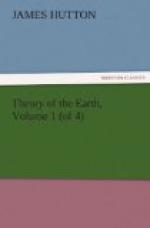Having thus endeavoured to remove this prevailing prejudice, of there being primitive parts in this earth, parts of which the composition and constitution are not to be explained upon the principles of natural philosophy, it will be proper to inquire, how far there may be in the theory, which has now been given, principles by which may be explained those appearances that have led natural philosophers to form conclusions, of there being in this earth parts whose origin may not be traced; and of there being parts whose origin may not be explained upon the same principles which apply so well to all the rest.
CHAP. V.
Concerning that which may be termed the Primary Part of the Present Earth.
In the present theory, it is maintained, that there is no part of the earth which has not had the same origin, so far as this consists in that earth being collected at the bottom of the sea, and afterwards produced, as land, along with masses of melted substances, by the operation of mineral causes. But, though all those things be similar, or equal, as to the manner of their production, they are far from being so with regard to the periods of their original composition, or to the subsequent operations which they may have undergone.
There is a certain order established for the progress of nature, for the succession of things, and for the circulation of matter upon the surface of this globe; and, the order of time is associated with this change of things. But it is not in equal portions that time is thus combined with dissimilar things, nor always found, in our estimation, as equally accompanying those which we reckon similar. The succession of light and darkness is that which, in those operations, appears to us most steady; the alternation of heat and cold comes next, but not with equal regularity in its periods. The succession of wet and dry upon the surface of the earth, though equally the work of nature and the effect of regular causes, is often to us irregular, when we look for equal periods in the course of things which are unequal. It is by equalities that we find order in things, and we wish to find order every where.
The present object of our contemplation is the alternation of land and water upon the surface of this globe. It is only in knowing this succession of things, that natural appearances can be explained; and it is only from the examination of those appearances, that any certain knowledge of this operation is to be obtained. But how shall we acquire the knowledge of a system calculated for millions, not of years only, nor of the ages of man, but of the races of men, and the successions of empires? There is no question here with regard to the memory of man, of any human record, which continues the memory of man from age to age; we must read the transactions of time past, in the present state of natural bodies; and, for the reading of this character, we have nothing but the laws of nature, established in the science of man by his inductive reasoning.




